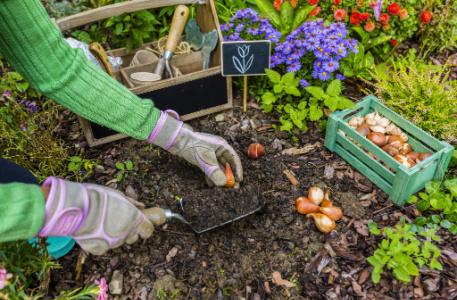
Planting Ahead: Rely on Fall Bulbs Now for Spring Blooms Later
Fall is in the air, and summer’s blossoms are winding down. For flower lovers, it’s a bittersweet time. But it’s also an ideal time to get a head start on spring blooms by adding bulbs to your garden. Follow these tips to improve your results!
Select the Best Bulbs
The healthiest bulbs are firm to the touch with no mold or rot. If you purchase them before planting time, store them in a cool, dry, and dark location.
Some of the most reliable and easy-to-grow options include:
Snowdrops - To enjoy the earliest spring blooms, plant a clump of a dozen or more snowdrops. Their tiny white blossoms will break through the ground undaunted by any lingering snow and ice.
Crocus - Following on the heels of snowdrops, crocus comes in vibrant shades of white, yellow, and purple, including striped varieties.
Scilla - Also called Siberian Squill, scilla are easy to grow and will create a carpet of delicate blue, pink, or white blooms that naturally scatter across perennial beds and lawns.
Tulips - Looking for colors that span the rainbow? Count on tulips. There are countless varieties, including some with fringed blooms. Perhaps tulips’ only downside is that they are not reliable repeat performers.
Daffodils - Unlike tulips, daffodils are incredibly long-lived and low maintenance. In addition to traditional yellow, you can find daffodils with orange, pink, and white splashes; some have unique ruffled edges.
Design Ideas for Spring-Flowering Bulbs
Plant in clusters - Bulbs look best when planted close together, so their blooms stand out and provide a colorful impact.
Arrange by height - Like perennials, it is usually best to plant taller bulbs behind shorter ones, especially if they bloom simultaneously.
Stagger bloom times - To create a steady display of flowers from early- to late spring, plant varieties that will bloom on different schedules.
Hide fading foliage - After your bulbs bloom, it’s best to let their foliage die back naturally. So, attempt to position clumps of spring-blooming bulbs among perennials that will fill in the bulbs’ spaces and help camouflage their fading foliage.
How to Plant Your Bulbs
Where - Plant your bulbs in a location that receives at least six hours of sunlight. Fortunately, that includes spots that receive sun over the winter but will be shaded by tree leaves after your bulbs bloom in the spring.
When - The best time to plant bulbs depends on your plant hardiness zone. As a general rule, wait until your nightly temperatures range from 40 to 50 degrees, but also make sure it’s about six weeks before the ground starts freezing. If possible, plant your bulbs earlier than later so they have more time to get established.
Depth - If you’ve selected a mixture of small and large bulbs, you’ll need to plant them at different depths. The general rule is to plant them 2.5 to 3 times as deep as the bulb’s height. So, for example, if your bulb is two inches tall, dig a hole at least 5 inches deep.
Soil prep - When digging holes, break up the soil, so it’s loose and clump-free. Consider adding compost or peat moss to improve drainage and provide nutrients. Once the bulbs are in place, lightly compress the soil over them.
Water - Lightly water each hole to help eliminate any remaining air pockets in the soil. But don’t continue watering your newly planted bulbs unless you live in an area that experiences dry winters.
Fertilize - Bulbs should remain dormant over the winter, so don’t fertilize them until the ground begins warming up in the spring and you spot their first shoots.
Now, sit back and relax, knowing you’re ready to enjoy a bounty of spring blooms once warm weather returns!
